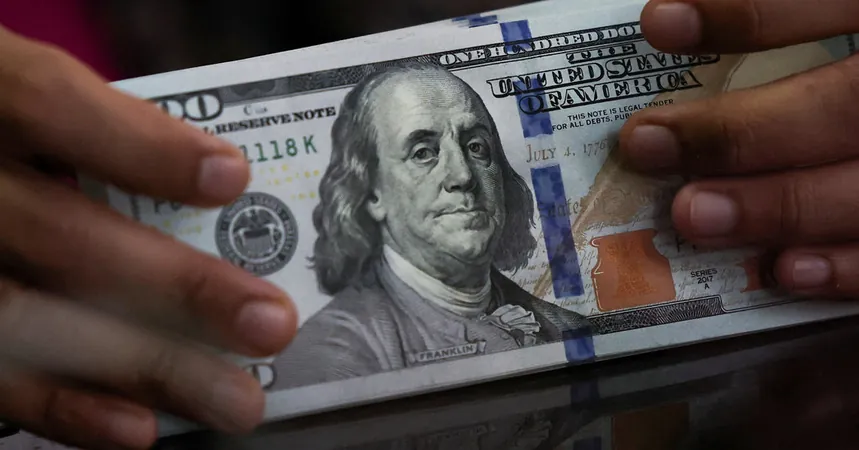
US Dollar Plummets Amidst Tariff Turmoil – What This Means for Investors
2025-04-14
Author: Jessica Wong
The U.S. dollar is on a slippery slope, continuing its descent against major currencies. This unsettling trend signals that investors are increasingly wary of what was once considered the safest haven in global finance.
For five consecutive days, the dollar index—tracking the currency against a basket of significant trading partners—has faltered, even as U.S. stocks and bonds experienced a rally. With an approximate 8% drop this year, the dollar is flirting with a three-year low.
The catalyst? President Trump's recent announcement of tariffs on imports from nearly every country, which has led to a sharp decline in the dollar's value against multiple currencies, including the euro, yen, and pound. This surge in costs could have American consumers paying more for foreign goods, even before tariffs are enacted.
Expectations had pointed towards a strengthening dollar as tariffs were imposed, driven by the notion that fewer Americans would buy imports, dropping demand for foreign currencies. Treasury Secretary Scott Bessent even projected that a dollar appreciation could offset potential inflation.
However, the scale of the tariffs has caught many off guard, stirring significant market turbulence. This has led to speculation on whether U.S. assets have lost their appeal, as there have been unsettling signs of simultaneous declines in both the dollar and U.S. equities—a situation highlighted by Krishna Guha from Evercore ISI as "rare, ugly and worrying."
Confusion reigns regarding Trump's tariff strategy, with fluctuating messages about exemptions which has unsettled investors who previously viewed dollar-denominated assets, like U.S. Treasury bonds, as stable and secure.
Economic experts like Joe Brusuelas warn that institutional investors and central banks must now grapple with what a diminishing dollar and Treasury market would mean for global safety.
The dollar's instability is alarming—being involved in nearly 90% of all foreign-exchange trades, it plays a pivotal role in the global economy. Essential commodities, such as oil, are generally priced in dollars, further emphasizing the currency's significance.
Brad Setser, from the Council on Foreign Relations, suggests there might be less to fear from the dollar's downturn than initially perceived. U.S. assets had thrived for nearly a decade, driven by high-performing tech stocks boosting the S&P 500.
"Money entering the U.S. has been more about chasing yield than safety," he stated, explaining that the altered risk perception post-tariff announcements is causing investors to reconsider their positions.
With rising trade tensions, economists are increasingly predicting a recession in the U.S., which could compel the Federal Reserve to lower interest rates to safeguard the labor market. Such a move would decrease the appeal of dollar-denominated assets, potentially exerting more pressure on the currency.
Fed Governor Christopher J. Waller indicated support for quicker and more substantial rate cuts than anticipated, acknowledging the markets' adverse reactions to Trump's tariffs.
The dollar could further weaken if Trump undermines the Federal Reserve's independence, which governs interest rates without political interference. Bessent emphasized the need to protect this vital monetary policy.
Looking ahead, Trump will have the opportunity to appoint a new Fed chair before Jerome H. Powell's term ends in May 2026. This pivotal decision will commence this fall.
Setser also hinted that beyond shifting expectations about economic prospects, there's a deeper concern surrounding investor confidence—wondering if they should continue pouring money into the U.S. amidst such policy uncertainty and recession threats.




 Brasil (PT)
Brasil (PT)
 Canada (EN)
Canada (EN)
 Chile (ES)
Chile (ES)
 Česko (CS)
Česko (CS)
 대한민국 (KO)
대한민국 (KO)
 España (ES)
España (ES)
 France (FR)
France (FR)
 Hong Kong (EN)
Hong Kong (EN)
 Italia (IT)
Italia (IT)
 日本 (JA)
日本 (JA)
 Magyarország (HU)
Magyarország (HU)
 Norge (NO)
Norge (NO)
 Polska (PL)
Polska (PL)
 Schweiz (DE)
Schweiz (DE)
 Singapore (EN)
Singapore (EN)
 Sverige (SV)
Sverige (SV)
 Suomi (FI)
Suomi (FI)
 Türkiye (TR)
Türkiye (TR)
 الإمارات العربية المتحدة (AR)
الإمارات العربية المتحدة (AR)